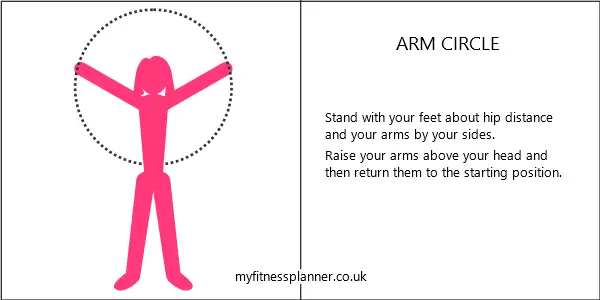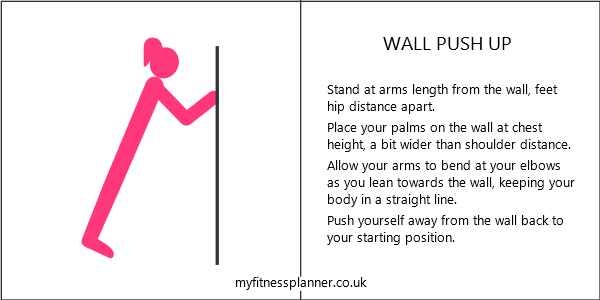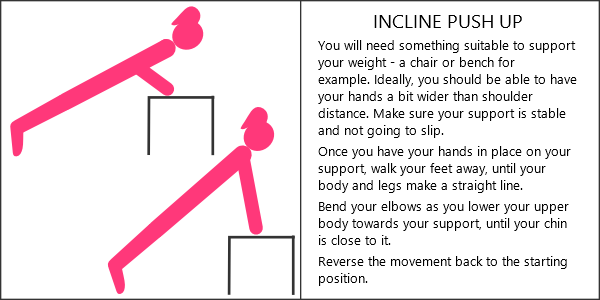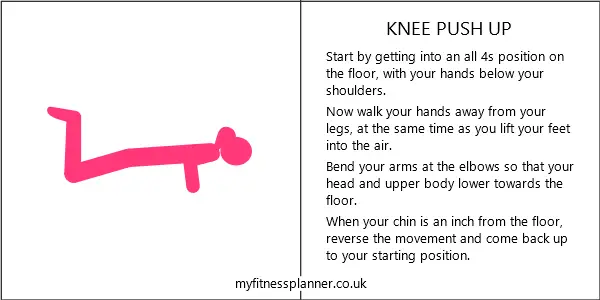There are lots of chest exercises you can do with weights and other resistance equipment, but the main body weight chest exercise is the push up. Full push ups require a lot of upper body strength and women often struggle to do even one, so need to start with a modified version. This push ups challenge for women uses 3 modified versions of the push up to build strength in the chest, shoulders and arms over the 30 days.
Push ups challenge for women
There are 3 levels of push up in this challenge: wall push ups, incline push ups and knee push ups. It starts with wall push ups and as you work through the 30 days, you start to do more incline push ups and knee push ups. The reps for each day are shown in the chart and instructions for the 3 versions are below the chart.
You’ll be more comfortable doing this if you have something to cushion your knees – ideally an exercise mat. See an exercise mat buying guide here.
Please read these safety guidelines before starting the challenge.
Arm circles to warm up
Before you do your push ups each day, warm up your arms, chest and shoulders with some arm circles as shown in the exercise instructions.
Push ups challenge for women schedule
These are the reps of the various types of push up for the 30 days of the challenge:

Exercise instructions
Warm up – arm circles
Do 3-5 of these in each direction

Push up variations



Benefits of push ups for women
Push ups mainly work the chest and triceps. Having firm, toned triceps muscles helps to avoid “bat wing” arms. Training the chest muscles helps to keep you firm and lifted. The core muscles and shoulders are also used in push ups to stabilise the body.
Related posts
Further reading
Harvard Health – the rise of push ups
Challenge FAQs
The first day of the challenge should feel like it needs a bit of effort, but not too much. If you really struggle with day 1, then you probably won’t get through the challenge. The idea with the challenges on this site is that the first few days get you used to the exercises and the daily habit. Usually about halfway through the challenge the effort levels start to increase more quickly.
Avoid challenges that increase effort levels very quickly – they’re simply not realistic. It’s unlikely that, for example, you would be able to increase how many squats you are able to do by 10 a day for 30 days, or increase your plank hold time by 10 seconds a day for 30 days.
Last Updated on: April 24, 2022In general, allowing muscles 48 hours between workouts is good because it gives our bodies time to recover and adapt. Challenges are generally short workouts and for a limited period of time (usually 30 days), so not having many rest days won’t be a problem. With challenges that alternate exercises each day, it’s not an issue, because you’re using different muscles.
Last Updated on: April 24, 2022Fitness improvements don’t always happen in a predictable way. Sometimes we’re just not as strong or energetic for no apparent reason, or we hit a plateau. If you get to a point where you’re struggling to complete the day’s challenge, you can try one of the following:
- Take a couple of days off and start again where you left off
- Do the challenge on alternate days rather than every day
- Instead of increasing the effort every day, stay at the same level for 2 or 3 days and then go onto the next day of the challenge
Obviously these solutions mean the challenge will last longer, but you’ll still benefit from doing it.
Last Updated on: April 24, 2022
